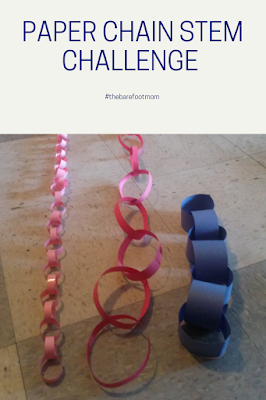My kids always love a good STEM challenge, so I thought I would share a favorite one from my childhood. The Paperchain Challenge is really simple to put together, all you need is: construction paper, scissors, tape or glue, and a couple of kids.
After a little discussion, my 8 year old decided to try skinny short paper strips for her rings. I wanted to make sure we had other chains to compare it to, so I helped my two year old make one with chubby paper strips, and I made one with long skinny strips.
The paper chain made of chubby paper strips was by far the shortest. The other two were almost the same length but the one made of long skinny paper strips was a little longer than the one made of skinny short paper strips.
The Paper Chain STEM Challenge
This challenge is fun for kids of almost any age. As long as they're old enough to handle scissors and tape, they can participate.
Start by handing each child a pair of scissors, some tape, and a single sheet of paper. I like to use colored construction paper so each child can have their own color, but any type of paper will work. Then challenge them to make the longest paper chain that they can with their single piece of paper.
Then let them do their thing. When everyone is finished, get out measuring tapes and measure each chain.
Have a discussion about which chain was longest and why. Did chubby or skinny rings make a longer chain? What about short or long rings?
A Look At Our Paper Chain STEM Challenge
After a little discussion, my 8 year old decided to try skinny short paper strips for her rings. I wanted to make sure we had other chains to compare it to, so I helped my two year old make one with chubby paper strips, and I made one with long skinny strips.
The paper chain made of chubby paper strips was by far the shortest. The other two were almost the same length but the one made of long skinny paper strips was a little longer than the one made of skinny short paper strips.
If you enjoyed this post, check out:



that's a great challenge. Makes me want to do it with a group of children. :)
ReplyDeleteIt would definitely be a fun group challenge!
Delete